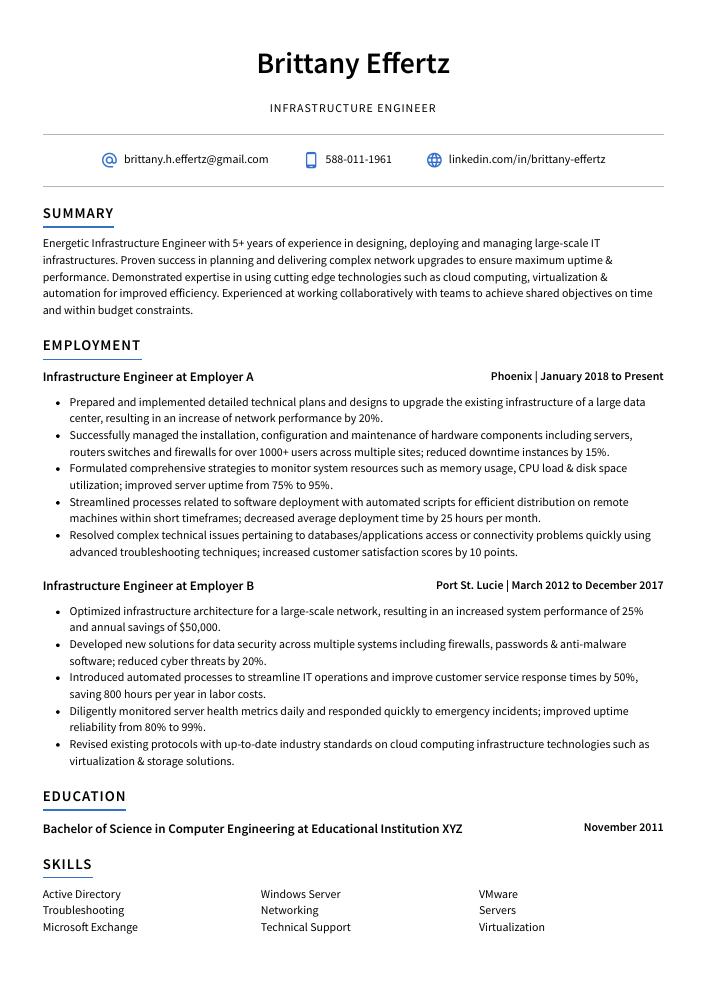Infrastructure Engineer Resume Guide
Infrastructure Engineers are responsible for designing, implementing and maintaining the technical infrastructure of an organization. They ensure that all systems are running smoothly to meet business requirements and objectives, as well as troubleshooting any issues that arise with hardware or software applications. Additionally, they often provide support to end-users on how to use new technologies effectively.
You have the technical experience and problem-solving skills necessary to make any infrastructure project successful. But employers don’t know who you are yet, so creating a winning resume is essential in order to get your foot in the door.
This guide will walk you through the entire process of creating a top-notch resume. We first show you a complete example and then break down what each resume section should look like.
Table of Contents
The guide is divided into sections for your convenience. You can read it from beginning to end or use the table of contents below to jump to a specific part.
Infrastructure Engineer Resume Sample
Brittany Effertz
Infrastructure Engineer
[email protected]
588-011-1961
linkedin.com/in/brittany-effertz
Summary
Energetic Infrastructure Engineer with 5+ years of experience in designing, deploying and managing large-scale IT infrastructures. Proven success in planning and delivering complex network upgrades to ensure maximum uptime & performance. Demonstrated expertise in using cutting edge technologies such as cloud computing, virtualization & automation for improved efficiency. Experienced at working collaboratively with teams to achieve shared objectives on time and within budget constraints.
Experience
Infrastructure Engineer, Employer A
Phoenix, Jan 2018 – Present
- Prepared and implemented detailed technical plans and designs to upgrade the existing infrastructure of a large data center, resulting in an increase of network performance by 20%.
- Successfully managed the installation, configuration and maintenance of hardware components including servers, routers switches and firewalls for over 1000+ users across multiple sites; reduced downtime instances by 15%.
- Formulated comprehensive strategies to monitor system resources such as memory usage, CPU load & disk space utilization; improved server uptime from 75% to 95%.
- Streamlined processes related to software deployment with automated scripts for efficient distribution on remote machines within short timeframes; decreased average deployment time by 25 hours per month.
- Resolved complex technical issues pertaining to databases/applications access or connectivity problems quickly using advanced troubleshooting techniques; increased customer satisfaction scores by 10 points.
Infrastructure Engineer, Employer B
Port St. Lucie, Mar 2012 – Dec 2017
- Optimized infrastructure architecture for a large-scale network, resulting in an increased system performance of 25% and annual savings of $50,000.
- Developed new solutions for data security across multiple systems including firewalls, passwords & anti-malware software; reduced cyber threats by 20%.
- Introduced automated processes to streamline IT operations and improve customer service response times by 50%, saving 800 hours per year in labor costs.
- Diligently monitored server health metrics daily and responded quickly to emergency incidents; improved uptime reliability from 80% to 99%.
- Revised existing protocols with up-to-date industry standards on cloud computing infrastructure technologies such as virtualization & storage solutions.
Skills
- Active Directory
- Windows Server
- VMware
- Troubleshooting
- Networking
- Servers
- Microsoft Exchange
- Technical Support
- Virtualization
Education
Bachelor of Science in Computer Engineering
Educational Institution XYZ
Nov 2011
Certifications
CompTIA Network+
CompTIA
May 2017
1. Summary / Objective
The summary/objective at the top of your resume is like an elevator pitch – it should provide a quick overview of who you are and why you make a great infrastructure engineer. You can use this section to highlight your technical skills, such as experience with system automation tools, cloud computing platforms, or network security protocols. You could also mention any certifications or awards that demonstrate your expertise in the field.
Below are some resume summary examples:
Professional infrastructure engineer with 8+ years of experience in designing, implementing, and maintaining large-scale IT systems. Strong background in developing and deploying cloud architecture solutions to optimize system performance. At ABC Corporation implemented a new data storage strategy that resulted in an estimated 20% cost savings for the company. Skilled at working with various operating systems (Linux/Windows) as well as scripting languages such as Python and Bash.
Seasoned infrastructure engineer with 7+ years of experience building, deploying and managing IT infrastructure. Proven success in developing high availability solutions that meet business needs while optimizing cost savings. At XYZ Technologies, designed robust network architecture which resulted in a 99% uptime rate for the company’s cloud services. Looking to join ABC Techs to further develop cutting-edge systems and maintain reliable operations within their global reach.
Hard-working and experienced Infrastructure Engineer with 5+ years of experience in designing, deploying, and maintaining secure networks. Skilled at analyzing system performance to identify potential problems and developing solutions to optimize the network environment. At XYZ Company successfully implemented security measures that reduced attack surface by 80%. Proven track record of troubleshooting complex technical issues while delivering excellent customer service.
Dependable Infrastructure Engineer with 7+ years of experience designing and maintaining complex IT systems. At XYZ, developed a web-based system for tracking server performance across multiple locations that saved $50K/year in maintenance costs. Specializes in networking protocols, cloud migrations, virtualization technologies, and storage solutions to optimize operations. Proven track record of delivering projects on time while improving the overall user experience.
Passionate infrastructure engineer with 7+ years of experience in designing, implementing, and maintaining computer networks. Skilled at troubleshooting network issues quickly and efficiently while adhering to best practices for security. At XYZ Corporation, designed a WAN architecture that enabled the company to reduce its operational costs by 15% annually. Received multiple awards as an outstanding performer in each project assigned during tenure at ABC Company.
Detail-oriented Infrastructure Engineer with 7+ years of successful experience in designing and deploying robust IT networks. Possess a deep knowledge of operating systems, hardware platforms, networking protocols, and security solutions. Proven ability to design cost-effective IT strategies that improve system performance by up to 20%. Seeking an opportunity at ABC Tech to help develop innovative network architectures for their clients worldwide.
Enthusiastic and highly-skilled infrastructure engineer with 5+ years of experience managing and maintaining server hardware, virtualization platforms, storage systems, networks, and databases. Seeking to join ABC as a senior member of the technical operations team. In past roles identified potential performance bottlenecks in existing architecture that led to an 18% improvement in overall system efficiency.
Determined Infrastructure Engineer with 7+ years of experience designing, deploying and managing complex IT infrastructure for organizations in dynamic environments. Proven track record of executing successful projects on time and within budget, while reducing operational costs by 15%. Seeking to join ABC Tech to provide reliable IT solutions that improve customer satisfaction.
2. Experience / Employment
For the experience section, you should list your employment history in reverse chronological order, meaning the most recent job is listed first.
Stick to bullet points when writing this section; doing so makes it easier for the reader to take in what you have written quickly. You want to provide detail on what you did and any quantifiable results achieved.
For example, instead of saying “Managed network infrastructure,” you could say, “Installed and maintained a complex network infrastructure spanning multiple sites with over 1,000 nodes resulting in 99% uptime.”
To write effective bullet points, begin with a strong verb or adverb. Industry specific verbs to use are:
- Configured
- Monitored
- Automated
- Optimized
- Implemented
- Troubleshot
- Resolved
- Upgraded
- Installed
- Analyzed
- Designed
- Secured
- Managed
- Tested
- Documented
Other general verbs you can use are:
- Achieved
- Advised
- Assessed
- Compiled
- Coordinated
- Demonstrated
- Developed
- Expedited
- Facilitated
- Formulated
- Improved
- Introduced
- Mentored
- Participated
- Prepared
- Presented
- Reduced
- Reorganized
- Represented
- Revised
- Spearheaded
- Streamlined
- Structured
- Utilized
Below are some example bullet points:
- Monitored and maintained the performance of over 400 computer systems, ensuring that they ran efficiently and securely by regularly performing diagnostics, troubleshooting issues and upgrading components; decreased system downtime by 45%.
- Reorganized the company’s entire IT infrastructure to ensure maximum efficiency while reducing overall costs; cut annual expenses related to maintenance/upgrades by $25K.
- Compiled detailed reports outlining network topology changes as well as usage statistics for all data points across multiple departments; improved team collaboration between departments by 30%.
- Structured a streamlined process for disaster recovery operations through replication & backups in order to quickly restore any lost data or services within two hours on average during emergency situations.
- Meticulously audited operating procedures for software deployments & updates for compliance with industry standards, resulting in zero security incidents due to improper configuration or installation errors since implementation of audit program one year ago.
- Analyzed and optimized existing infrastructure to identify and resolve technical issues, decreasing system downtime by 30% over the past year.
- Facilitated server migration projects for various clients using cloud platforms such as AWS and Azure; ensured that all applications were up and running on the new systems without any interruptions in services.
- Automated routine tasks related to data backups, software upgrades & patch management across multiple networks; saved 135 hours of manual labor each month for IT team members.
- Actively monitored network performance metrics including bandwidth utilization rates, latency times & uptime/downtime statistics to ensure optimal usage experience for users at all times.
- Mentored junior engineers on developing high-quality code in order to create more efficient web applications; collaboratively improved development speed by 60%.
- Resourcefully installed and maintained over 350 routers, switches, firewalls and other network components to ensure optimal performance of the corporate IT infrastructure.
- Secured data networks by implementing robust encryption algorithms across all systems; reduced system vulnerabilities by 14%.
- Expedited troubleshooting tasks such as network outages, latency issues and configuration changes resulting in an average resolution time of under 60 minutes per incident.
- Reduced organization’s overall downtime costs through proactive maintenance services on server hardware/software applications as well as preventive monitoring solutions for critical business processes.
- Optimized customer experience with faster response times via constant evaluation & improvement of Wi-Fi coverage, LAN speed & quality of service (QoS) metrics at multiple locations with minimal disruption to operations +40%.
- Presented and implemented innovative engineering solutions that substantially reduced operating costs by 20%.
- Spearheaded the design and installation of new server infrastructure, increasing efficiency by 30% while maintaining system reliability.
- Coordinated 10+ team members to complete projects within tight deadlines and budget restrictions; successfully delivered 5 major rollouts in the last 12 months.
- Advised senior management on various IT strategies for optimizing existing systems, resulting in a 25% improvement in network performance over 6-month period.
- Developed comprehensive disaster recovery plans for protecting vital business data from potential security threats with 100% success rate achieved to date.
- Documented and maintained all infrastructure engineering plans, drawings and schematics; ensured accuracy of data by double-checking all entries before submission.
- Designed and implemented a secure network system architecture that increased bandwidth performance by 50%.
- Managed the installation of over 200 client systems with minimum disruption to business operations; completed project within budget and 10% ahead of schedule.
- Confidently diagnosed complex technical issues related to computer hardware, software applications, networks & other IT components in order to resolve them quickly & efficiently with minimal downtime for clients attending our service desk center.
- Troubleshot various server problems while providing 24/7 support services onsite or remotely at customer premises; reduced number of unresolved incidents from 3% to 1% in just 4 months’ time frame.
- Competently tested, maintained and optimized new infrastructure systems to ensure optimum performance; successfully increased system uptime by 20%.
- Implemented best practices for network security protocols to protect confidential data from hacking attempts; decreased online cyberattacks by 30% over the course of 1 year.
- Utilized advanced automation tools and scripting languages such as Python, Bash, Terraform & Ansible to streamline complex IT processes with improved efficiency across departments.
- Participated in cross-functional design reviews, providing valuable insight into potential areas of improvement within existing architectures and reducing development time by 25%.
- Successfully launched 3 IT projects on schedule while staying within budget constraints; saved company $45K in operational costs annually through cost optimization measures implemented during project lifecycle management process.
- Independently designed, installed and maintained hundreds of IT infrastructure systems for various clients, ensuring high-level performance standards were achieved.
- Represented the engineering team in meetings with stakeholders to discuss technical specifications and proposed upgrades; implemented changes that increased system efficiency by 20%.
- Upgraded existing computer hardware and software components on a regular basis to ensure compatibility with emerging technologies; reduced overall costs by $6,000 over the course of 6 months.
- Configured network settings such as IP addresses, DNS servers & subnets according to organizational requirements while troubleshooting any related issues within 2 hours or less on average per request/incident report.
- Achieved 100% customer satisfaction ratings following successful implementation of projects involving server migrations & installations, cloud computing set-ups & virtualization solutions across multiple sites worldwide.
- Assessed infrastructure weaknesses and developed comprehensive design plans to improve the security, performance and scalability of systems for over 100 users; achieved a 30% reduction in IT service outages.
- Demonstrated advanced knowledge of hardware installation and software configuration on Windows & Linux operating systems to ensure that all components were properly set up with minimal downtime.
- Improved system efficiency by 15%, reducing costs associated with maintenance and repairs while increasing user satisfaction ratings across multiple departments within the company.
- Reliably maintained network infrastructure (including patching cables, switching/routing devices & firewalls) in line with industry standards as part of regular preventive maintenance activities, resulting in less than 10 hours’ total unplanned downtime per year for 3 years running.
3. Skills
Even though two organizations are hiring for the same role, the skillset they want an ideal candidate to possess could differ significantly. For instance, one may be on the lookout for an individual with experience in developing and deploying cloud-based infrastructure, while the other may be looking for someone with a strong background in network engineering.
It is essential to tailor your skills section according to each job you are applying for because many employers use applicant tracking systems these days that scan resumes for certain keywords before passing them on to a human.
You can further elaborate on your qualifications by discussing it more thoroughly in other areas of the resume, such as the summary or work history sections.
Below is a list of common skills & terms:
- Active Directory
- Amazon Web Services
- Backup Exec
- BlackBerry Enterprise Server
- Business Analysis
- Change Management
- Citrix
- Cloud Computing
- Computer Hardware
- DHCP
- DNS
- Data Center
- Databases
- Disaster Recovery
- Firewalls
- Group Policy
- HTML
- Hardware
- Help Desk Support
- IIS
- IT Management
- IT Operations
- IT Service Management
- ITIL
- Information Technology
- Infrastructure
- Integration
- Java
- JavaScript
- Linux
- Microsoft Exchange
- Microsoft SQL Server
- Microsoft Technologies
- MySQL
- Network Administration
- Network Security
- Networking
- Office 365
- Operating Systems
- PowerShell
- Process Improvement
- Python
- Red Hat Linux
- Routers
- SCCM
- SQL
- San
- Security
- Servers
- SharePoint
- Software Documentation
- Software Installation
- Storage
- Switches
- System Administration
- System Deployment
- TCP/IP
- Team Leadership
- Technical Support
- Telecommunications
- Troubleshooting
- Unix
- VMware
- VMware ESX
- VMware Infrastructure
- VMware vSphere
- VPN
- Vendor Management
- Virtualization
- VoIP
- Windows
- Windows 7
- Windows Server
- Windows XP
- Wireless Networking
4. Education
Mentioning an education section on your resume will depend largely on how far along you are in your career. If you just graduated and have no work experience, include an education section below your resume objective. However, if you have a long history of relevant engineering experience to showcase, omitting the education section is perfectly acceptable.
If including an education section is necessary, try to mention courses related to infrastructure engineering that were taken while obtaining higher degrees or certifications.
Bachelor of Science in Computer Engineering
Educational Institution XYZ
Nov 2011
5. Certifications
Certifications demonstrate to a potential employer that you have the necessary knowledge and skills required for the job. It is important to include any certifications related to your field of expertise in this section of your resume, as it will give employers an indication that you are up-to-date with industry standards.
Including certifications on your resume can be beneficial when applying for jobs, as they show employers that you have taken initiative in furthering your professional development.
CompTIA Network+
CompTIA
May 2017
6. Contact Info
Your name should be the first thing a reader sees when viewing your resume, so ensure its positioning is prominent. Your phone number should be written in the most commonly used format in your country/city/state, and your email address should be professional.
You can also choose to include a link to your LinkedIn profile, personal website, or other online platforms relevant to your industry.
Finally, name your resume file appropriately to help hiring managers; for Brittany Effertz, this would be Brittany-Effertz-resume.pdf or Brittany-Effertz-resume.docx.
7. Cover Letter
Attaching a cover letter to your job application is a great way to demonstrate your enthusiasm for the role and provide employers with an insight into what you can bring to their company.
Cover letters are typically made up of 2-4 paragraphs, which explain why you’re suitable for the position and highlight any key skills or qualifications that may not be outlined in your resume. They also give you an opportunity to express yourself more personally than a CV allows.
Writing a cover letter isn’t always necessary when applying for jobs, however it’s highly recommended as they help demonstrate just how passionate and dedicated you are about the role!
Below is an example cover letter:
Dear Joany,
I am writing to apply for the position of Infrastructure Engineer at XYZ Corporation. With more than 10 years’ experience in designing, building, and maintaining large-scale network and server infrastructure, I believe I am an ideal candidate for this role.
In my current role as Infrastructure Engineer at ABC Corporation, I have been responsible for managing a team of 12 engineers who design, build, and maintain the company’s network and server infrastructure. In addition to this, I have also been responsible for ensuring that all infrastructure projects are completed on time and within budget. Some of the notable projects that I have managed include the rollout of a new VoIP system across all offices worldwide, as well as the migration of all servers from physical to virtual environments.
I am confident that I can bring my experience and expertise to XYZ Corporation and contribute to the success of your organization. If you have any questions or would like to discuss my application further, please do not hesitate to contact me at [phone number] or [email address].
Thank you for your time and consideration.
Sincerely,
Brittany
Infrastructure Engineer Resume Templates
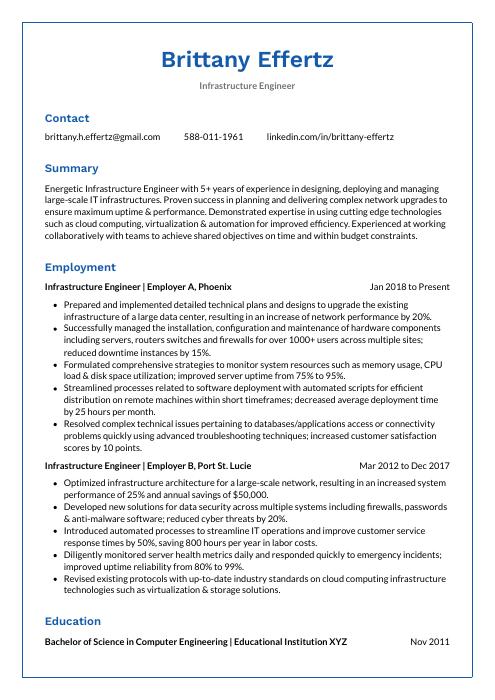 Markhor
Markhor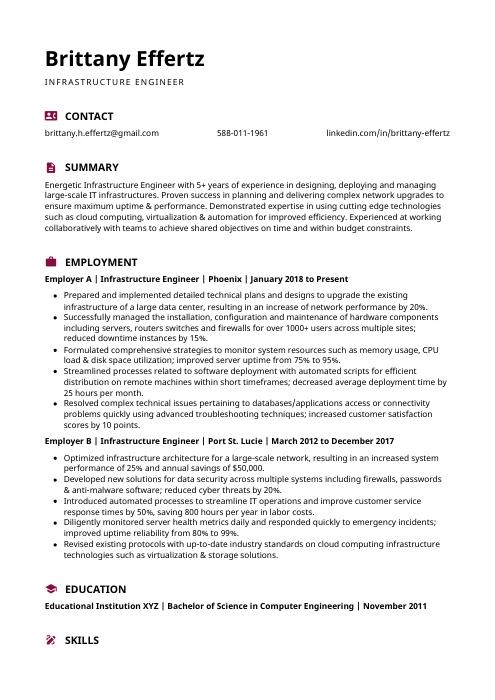 Hoopoe
Hoopoe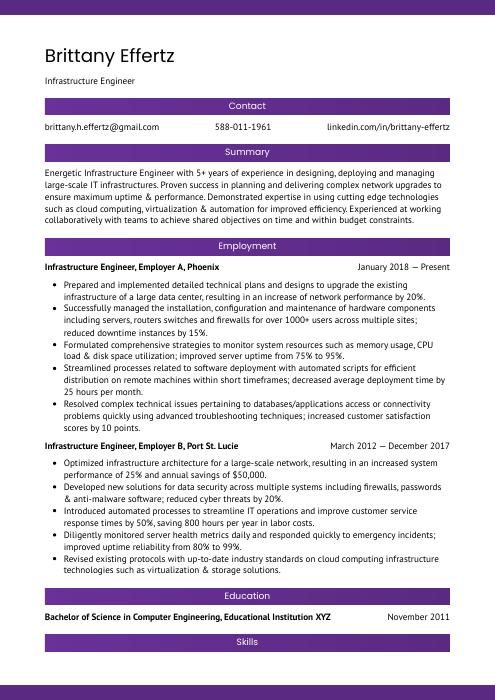 Jerboa
Jerboa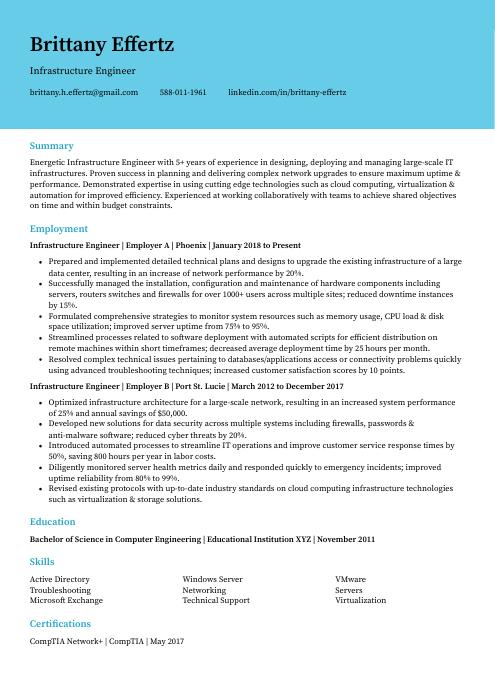 Dugong
Dugong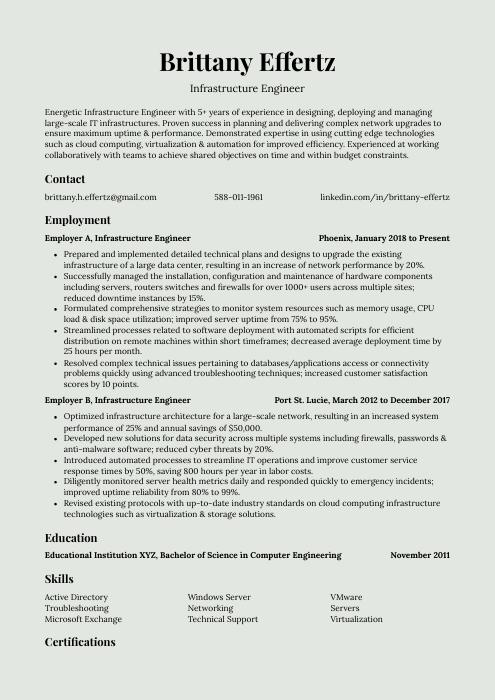 Saola
Saola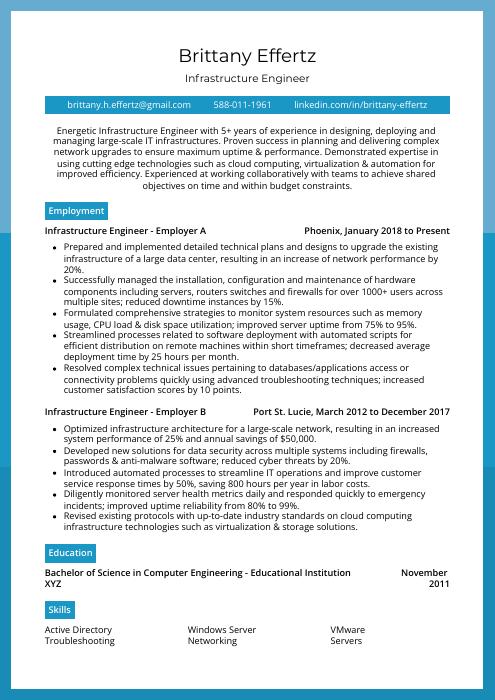 Rhea
Rhea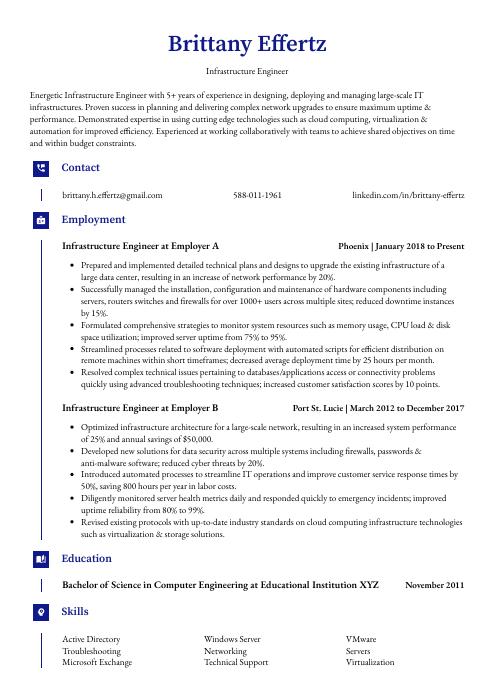 Gharial
Gharial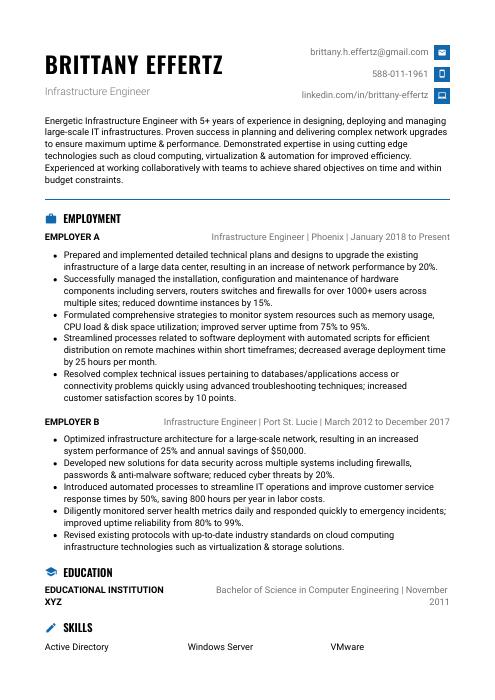 Echidna
Echidna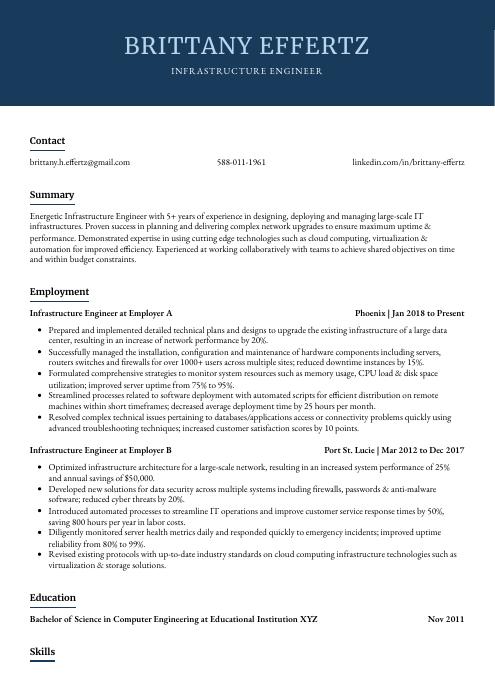 Bonobo
Bonobo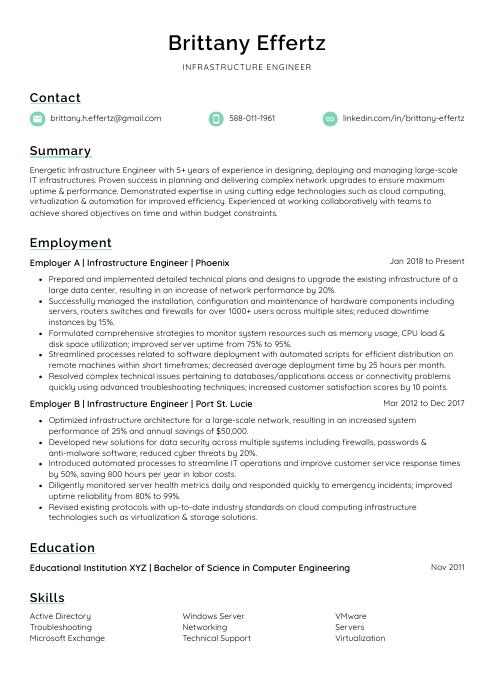 Lorikeet
Lorikeet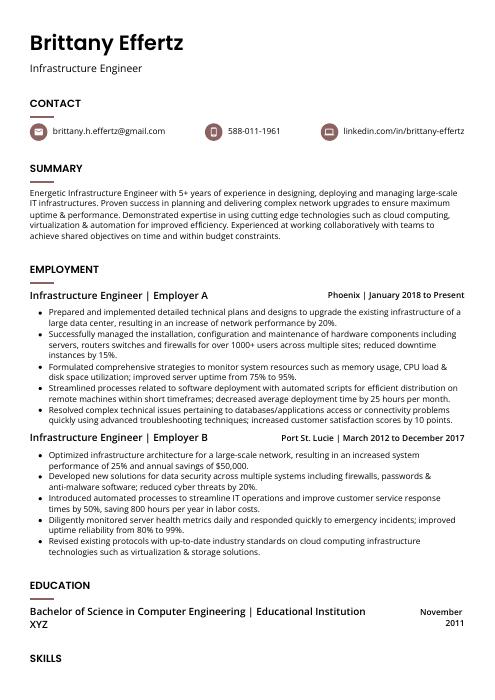 Fossa
Fossa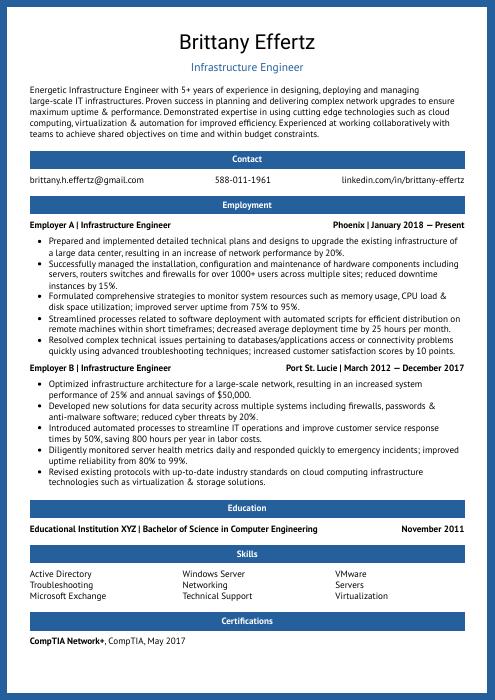 Ocelot
Ocelot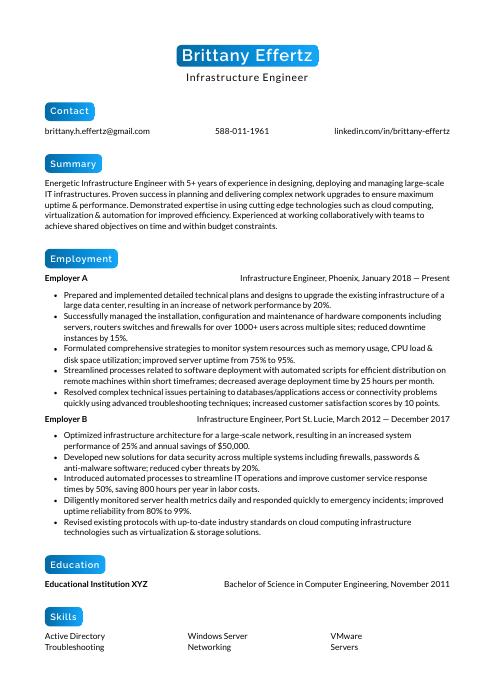 Kinkajou
Kinkajou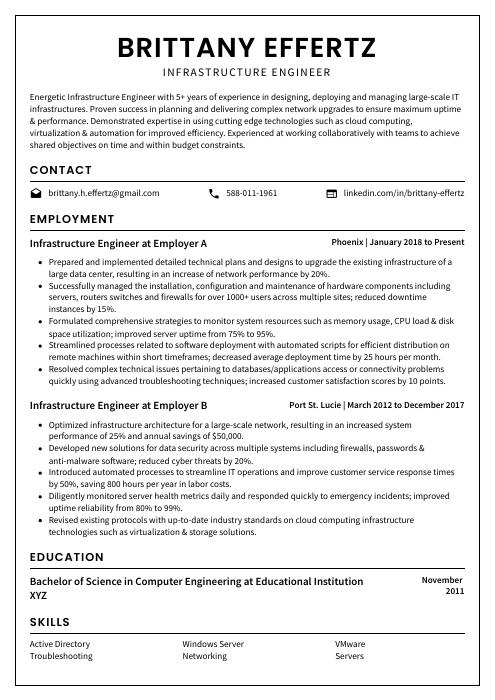 Cormorant
Cormorant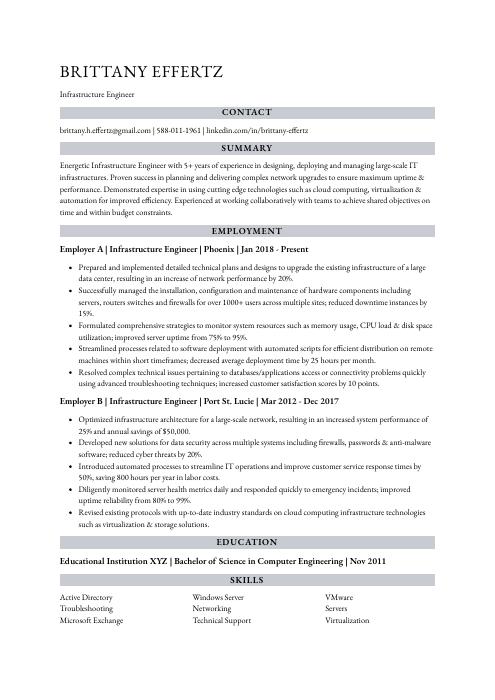 Numbat
Numbat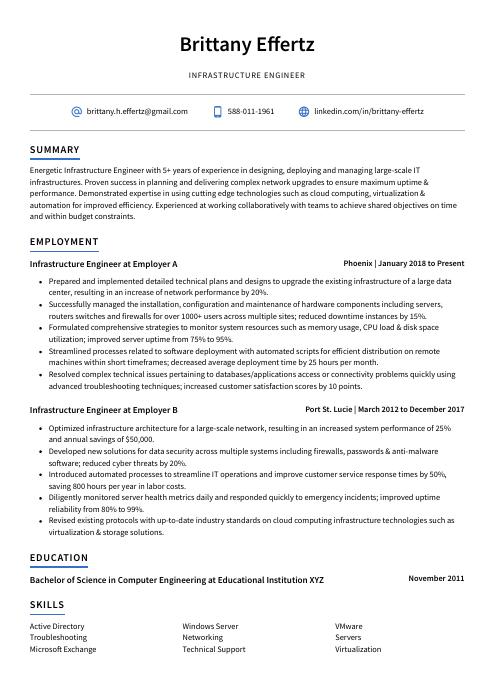 Axolotl
Axolotl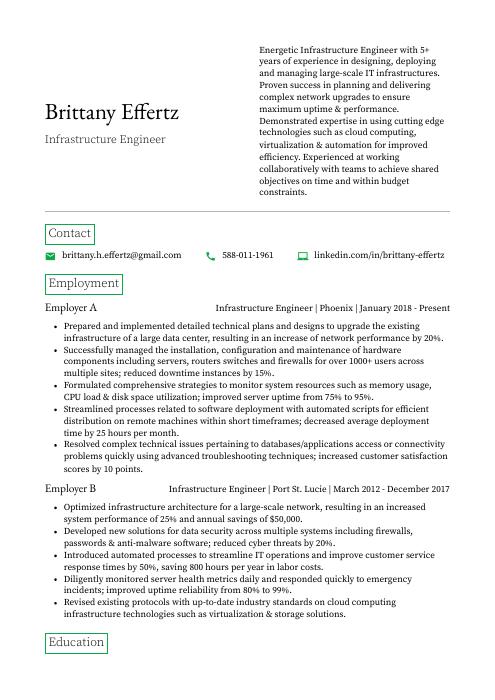 Quokka
Quokka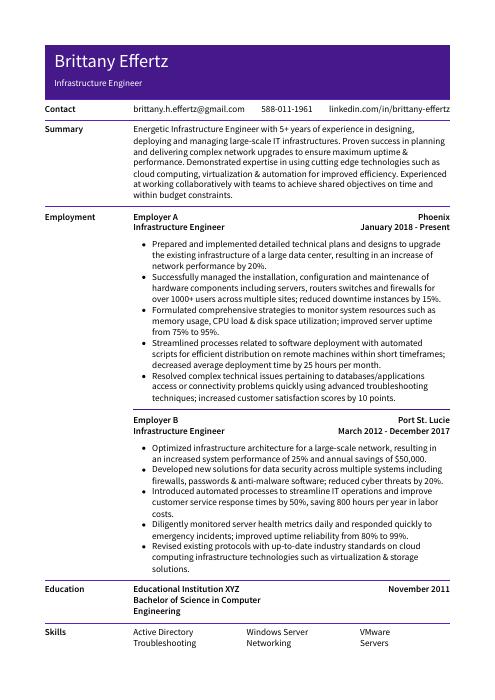 Pika
Pika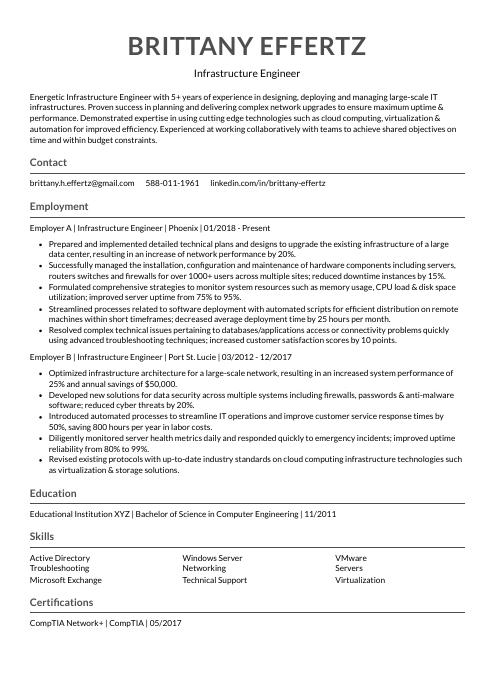 Indri
Indri Rezjumei
Rezjumei
